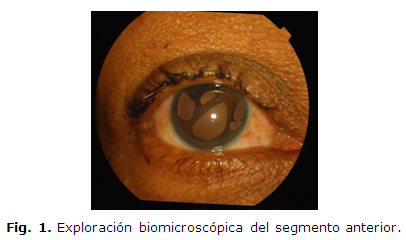Iridocorneal endothelial syndrome: a case report
Keywords:
DeCS, Iridocorneal endothelial syndrome, Iris diseases.Abstract
Introduction: the iridocorneal endothelial syndrome is a constellation of non-hereditary disorders, generally unilateral and of progressive evolution, which more frequently present in young and middle-aged women. It is one of a group of secondary types of glaucoma of corneal cause, and it can start with a acute glaucoma, although the patient may previously have noticed alteration in the iris or the cornea.
Clinical case: a 49-year-old patient presented to the Pinar del Río Province Glaucoma Department with painful blind right eye, iris atrophy, polycoria and secondary glaucoma with marked ocular hypertension. After being jointly evaluated in the Ophthalmology Service, the patient was diagnosed with the iridocorneal endothelial syndrome.
Conclusions: the iridocorneal endothelial syndrome is more frequently manifested in the female sex. It is a little frequent entity among the ophthalmologic diseases and among the glaucoma group it is of very low visual prognosis. It is necessary to carry out more studies permitting to obtain greater evidences about this syndrome. The adequate evaluation of these patients is vitally important, for early diagnosis and timely treatment.
Downloads
References
1. Kanski Jack J. Oftalmología clínica. 7ma. ed. Madrid: Elsevier. 2012
2. Navarro Vivó J, Herrera Hernández N. Síndrome iridocorneal-endotelial: presentación de un caso. Rev Méd Electrón [Internet]. 2012 Sep-Oct [citado: fecha de acceso]; 34(5). Disponible en: http://www.revmatanzas.sld.cu/revista%20medica/ano%202012/vol5%202012/tema07.htm
3. American Academy of Oftalmology. Glaucoma. San Francisco, CA: American Academy of Oftalmology; 2008. p. 142-4.
4. Berbes Villalón E, González Delgado RI, Massó Duverger N. Síndrome endotelial iridocorneal: reporte de un caso. Rev Méd Electrón [Internet]. 2011 Jun-Jul [citado: fecha de acceso]; 33(4). Disponible en: http://www.revmatanzas.sld.cu/revista%20medica/ano%202011/vol4%202011/tema14.htm
5. Gomez Castillo Z; Fernandez Garcia K; Perez Tejeda A; Marquez Villalon S; Jareño Ochoa M ;Cuevas Ruiz J.Microscopia confocal en corneas de Cien ojos sanos . Rev Cubana Oftalmología [revista en la Internet].2012 Dic. [citado: 2014 Mayo 23]; 25(1). Disponible en: http://scielo.sld.cu/scielo.php?script=sci_arttextpid=S0864-21762012000100005lng=esnrm=iso
6. A. Capote, T. Cárdenas; D. Cruz ;I. Hernández. Queratoplastia endotelial con pelado de la Descemet asistida con láser de excímero en el síndrome iridocorneoendotelial. Archivos de la Sociedad Española de oftalmología. [Internet].2013, [citado: 2014 Mayo 23]; 88(8). Disponible en: http://dialnet.unirioja.es/servlet/articulo?codigo=4368796
7. Cabeza Martínez E, Peral Martínez I, Pereira Nodarse RM. Síndrome iridocorneo endothelial en paciente portadora de Síndrome de Marfán. Reporte de un caso. Infociencia [Internet]. 2010 Abr-Jun [citado 7 Oct 2011]; 14(2). Disponible en: http://www.google.com.cu/url?q=http://infociencia.idict.cu/infociencia/article/download/52/48&sa=U&ei=WC_6UvnHH-7J0AHk-4GgDg&ved=0CCEQFjAA&usg=AFQjCNE9Fqcu4V3tgiI_9M2C4yPMat-rew
8. Robert AM. Renard G, Robert L, Bourges JL. The irido-corneo-endothelial syndrome. The loss of the control of corneal endothelial cell cycle. A review.. Pathologie-biologie, 2012 [Internet]. Disponible en: http://www.torna.do/s/The-irido-corneo-endothelial-syndrome-The-loss-of-the-control-of-corneal-endothelial-cell-cycle-A-review/
9. Caillaux V, Labbé A, Goemaere I, Lecuen N, Laroche L, et al.. Role of in vivo confocal microscopy in irido-corneo-endothelial syndromes." Journal français d'ophtalmologie 35:9 2012 Nov pg 716.e1-5.
10. Caillaux V, Labbé A, Goemaere I, Lecuen N, Laroche L, et al. Apport de la microscopie confocale in vivo dans les syndromes irido-cornéo-endothéliaux. Journal Français d'Ophtalmologie, 2012, vol. 35, no 9, p. 716. e1-716. e5.
11. Navarro Vivó J, Herrera Hernández N. Síndrome iridocorneal-endotelial: presentación de un caso. Rev Méd Electrón [Internet]. 2012 Sep-Oct [citado: fecha de acceso]; 34(5). Disponible en: http://www.revmatanzas.sld.cu/revista%20medica/ano%202012/vol5%202012/tema07.htm
12. Torriente Torriente V; Ruiz Roja B;Vega Torres M; Gamboa Escanelle B; Triana Casado I;Martínez Legon Z C.Facoemulsificación en el síndrome iridocorneo endotelial.Rev Cubana Oftalmología [revista en la Internet].2013 Dic. [citado: 2014 Mayo 23];26(3). Disponible en: http://scielo.sld.cu/scielo.php?script=sci_arttextpid=S0864-21762013000300017lng=esnrm=iso

Published
How to Cite
Issue
Section
License
Authors who have publications with this journal agree to the following terms: Authors will retain their copyrights and grant the journal the right of first publication of their work, which will be publication of their work, which will be simultaneously subject to the Creative Commons Attribution License (CC-BY-NC 4.0) that allows third parties to share the work as long as its author and first publication in this journal are indicated.
Authors may adopt other non-exclusive license agreements for distribution of the published version of the work (e.g.: deposit it in an institutional telematic archive or publish it in a volume). Likewise, and according to the recommendations of the Medical Sciences Editorial (ECIMED), authors must declare in each article their contribution according to the CRediT taxonomy (contributor roles). This taxonomy includes 14 roles, which can be used to represent the tasks typically performed by contributors in scientific academic production. It should be consulted in monograph) whenever initial publication in this journal is indicated. Authors are allowed and encouraged to disseminate their work through the Internet (e.g., in institutional telematic archives or on their web page) before and during the submission process, which may produce interesting exchanges and increase citations of the published work. (See The effect of open access). https://casrai.org/credit/


